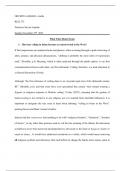ORVIETO-AGIMAN, Arielle
RELI 372
Professor Steven Lapidus
Sunday November 19th 2023
Final Take Home Exam
1. How has veiling in Islam become so controversial in the West?
If first impressions are unuttered looks and glances, often occurring through a quick observing of
attire, posture, and physical demarcations, “clothing is probably the most silent of expressions
used.” (Hoodfar, p.3) Dressing, which is often analyzed through the public sphere, is our first
communication between each other, our first informant. Veiling, therefore, is a loud statement in
a silenced discussion of looks.
Although “the first reference of veiling dates to an Assyrian legal text of the thirteenth century
BC” (Hoodfar, p.6), and that some have even speculated that certain “men started wearing a
Kippah, in religious response to Muslim veiling” (Cohn, 2022*), meaning that the gesture of
head-covering is not exclusive to one religion, nor is it isolated from interfaith influences; it is
important to designate the true issue at hand when debating “veiling in Islam in the West”:
policing brown and black women’s bodies.
Indeed, had this controversy had anything to do with “religious freedom”, “feminism”, “freedom
of choice”, or any other false pretense used to veil the true meaning of the debate, the discussion
would have never been narrowed and pinpointed so obviously to the hijab or burqa or chador or
niqab or abaya... It would have addressed secularism as a whole, which would mean removing
all religious symbols and references. But God forbid we change the Saints street names, paint in
,red and behead the omnipresent statues of the missionary colonizers, or take down crosses at
National Assemblies, right?
How could we ever laïcize the public sphere, if de-evangelizing the city would mean holding
History accountable and disaggregating the Christian symbols that have immiscer themselves in
all parts of “Western” cities?
This is to say, that somehow the imbricated, looming, systems of oppression, meaning the
Patriarchy, and Imperial-Colonialism (with their love child, Capitalism), managed to combine
new ways of maintaining their hegemonic powers, which was to find their newest antagonist and
arch nemesis: Islam. Yet being Islamophobic couldn’t have been enough to recruit followers to
their mission, the West had to find ways of first-wave feminizing their movement, that is to say,
internalized misogyny (with the “family-values” flavor of white supremacy). So not only is the
controversy Islamophobic, namely through “the tendency of Western scholarly work and the
colonial authorities to present a one-dimensional image of Islam” (Hoodfar, p.11), it is also
blatantly misogynistic, with its “lack of recognition of women’s agency, and the tendency to
view women as passive victims, that has flawed the current debate, distorted the image of veiled
women and promoted the divide between those who do and those who do not wear the hijab”.
(Hoodfar, p.39)
Therefore, to truly grasp how veiling in Islam has become so controversial in the West, we
must tackle two essential points: 1) Islam as the new Commie, or “the Clash of Civilizations”
and 2) Infantilizing women of color, the leftover sequelae of the Suffragettes.
, Let’s begin with: after the RedFear, and the War on Drugs, socialism-communism or any
community-oriented ideals have a new movement, except this time, it’s a Religion (rather than a
political party, figure, or monolithic state).
In the methodology manual “Understanding Religion: theories and methods for studying
religiously diverse societies” by Paul Hedges, is is said that:
“In the twenty-first century, many associate religion with violence, and as
contrary to whatever they imagine “Western values” to be. This critique of religion is
often leveled, especially against Islam. Many Muslims proclaim that theirs is “the
religion of peace”, and compatible with democracy, freedom, and human rights. An
inevitable confrontation between the West, often portrayed as Christian, and the Muslim-
majority world, was theorized by Samuel Huntington under the terminology of a “clash
of civilizations,” This suggests future fault lines lie between major civilizational blocs,
with three main ones being Western, Islamic and Confucian.” (Hedges, p.331)
Although the American (self-proclaimed Hero or Bearer of Western values) narrative does put
itself in opposition to “the Muslim-majority world” and countries, and to China, it is important to
identify a few flaws within this theorem.
Namely “the world’s largest Muslim-majority country is not in the Middle East; it is in Indonesia
an area which has seen centuries of relative religious harmony and peace compared to the rest of
the world.” (Hedges, p.331)
And more importantly, “suggestions that Islam is at war with the West can be met with a
response that it is, if anything a war of self-defence. Many Muslims have perceived the War in
Terror as primarily a Western cover to continue its “crusade” against Islam […] as part of
ongoing Christian-centric aggression against them”. (Hedges, p.331)




